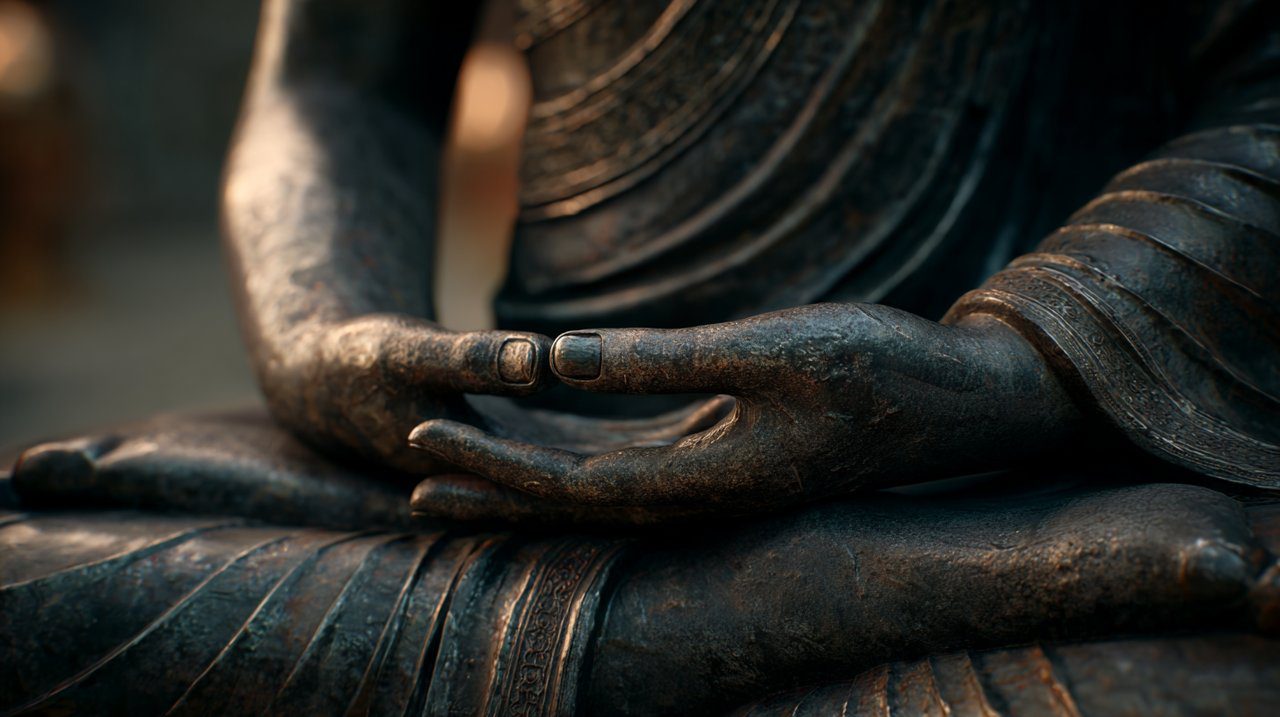What Does The Buddha Symbolize: A Guide to Its Profound Meanings
For many, the image of the Buddha evokes a profound sense of serene calm, often perceived as a distant figure radiating peace. Yet, this widely recognized symbol holds layers of meaning far beyond a simple idol or historical persona. It serves as a dynamic emblem, guiding countless individuals toward a deeper understanding of existence and their own intricate inner landscape. To truly unpack what the Buddha symbolizes is not merely an academic exercise; it is an invitation to explore the very essence of human awakening and potential.

The Universal Core: What Does The Buddha Symbolize?
At its heart, the Buddha symbolizes enlightenment—a state of profound wisdom and liberation from suffering. This fundamental understanding transcends the notion of worshipping a deity; rather, it acknowledges a human being who achieved an ultimate state of insight. Siddhartha Gautama, the historical Buddha, thus represents the innate potential within every individual to transcend worldly attachments and realize their inherent purity.
His serene countenance embodies the cultivated qualities of inner peace and compassion, forged through rigorous self-discipline and meditative practice. The symbol itself serves as a constant reminder that true tranquility is an internal journey, accessible to all who earnestly seek it. It points not to an external savior, but profoundly toward an internal guide: the awakened mind itself.
Unveiling Nuance: Postures, Mudras, And Implements
The rich iconography of the Buddha is far from arbitrary; instead, every posture, hand gesture, and accompanying implement is imbued with specific, profound spiritual significance. These elements function as visual metaphors, offering silent yet potent teachings on the arduous path to awakening.
Seated Meditative Postures: The Path To Inner Stillness
Buddhist art frequently depicts the Buddha in various seated positions, each reflecting a particular stage or aspect of his spiritual journey. The most iconic is the Lotus Position (Padmasana), where legs are crossed with feet resting upon opposite thighs. This posture powerfully symbolizes:
- Stability and Balance: A firm foundation indispensable for deep, sustained meditation.
- Spiritual Growth: The lotus flower, emerging pure and unstained from muddy waters, mirrors the mind’s remarkable ability to rise above defilements and impurities.
These postures are not mere physical forms; they are the external manifestations of an internal state of perfect composure and unwavering focus, absolutely essential for the cultivation of profound insight.
Hand Gestures (Mudras): Keys To Spiritual States

Mudras, or symbolic hand gestures, are central to comprehending what the Buddha symbolizes in greater depth. Each mudra conveys a specific meaning, emotion, or action, acting as a concise spiritual lexicon:
- Bhumisparsha Mudra (Earth-Touching): The right hand reaches down to touch the earth, symbolizing the Buddha’s pivotal moment of enlightenment under the Bodhi tree. It represents his call to the Earth as witness to his unwavering resolve and ultimate realization of truth, even in the face of profound temptations.
- Dhyana Mudra (Meditation): Both hands rest in the lap, palms upward, fingers extended, often with thumbs touching to form a mystic triangle. This gesture signifies deep contemplation, profound meditation, and the attainment of spiritual perfection.
- Abhaya Mudra (Fearlessness): The right hand is raised, palm outward, fingers extended upwards. This mudra conveys protection, reassurance, and the active dispelling of fear. It stands as an invitation to approach without trepidation.
- Dharmachakra Mudra (Teaching): Both hands are held at chest level, with the thumbs and index fingers forming circles. This represents the "turning of the Wheel of Dharma", symbolizing the Buddha’s first sermon and the initiation of his liberating teachings.
Sacred Implements: Tools Of Transformation
Beyond the body’s forms and gestures, certain objects frequently associated with the Buddha also carry significant symbolic weight, functioning as potent tools of transformation:
- Alms Bowl: This simple bowl represents humility, detachment from material possessions, and the acceptance of generosity from others. It powerfully underscores the monastic life of simplicity and reliance.
- Lotus Flower: Appearing pure and unstained despite growing from mud, the lotus symbolizes purity, spiritual awakening, and liberation from the defilements of the world. It is a powerful emblem of profound transformation.
- Bodhi Tree: The specific fig tree under which Siddhartha Gautama attained enlightenment. It stands as the unequivocal symbol for the place of awakening and the ultimate realization of truth.
Buddha’s Echoes: Symbolism Across Cultures And Seekers
The symbolism of Buddha in different cultures vividly illustrates how a universal message adapts and flourishes within diverse societal contexts. While the core tenets remain steadfast, cultural nuances invariably shape their expression and emphasis.
Cultural Interpretations: A Tapestry Of Meaning
- In Southeast Asia (e.g., Thailand, Myanmar), Buddha statues often emphasize a serene, detached aspect, reflecting a strong monastic tradition and the pursuit of Nibbana (Nirvana) through merit-making and meditation.
- East Asian Buddhism (e.g., China, Japan, Korea) frequently integrates with local philosophies like Taoism and Confucianism. For instance, the laughing Buddha (Budai) in China symbolizes prosperity and contentment, offering a more jovial interpretation than the historical Buddha. Zen Buddhism in Japan, notably, emphasizes direct experience and meditative insight.
- Tibetan Buddhism features a rich pantheon of Buddhas and Bodhisattvas, incorporating intricate mandalas and sometimes wrathful deities, symbolizing the fierce determination required to overcome obstacles on the path to enlightenment, with practices sometimes involving a Tibetan mala.
Despite these compelling variations, the fundamental message of compassion, wisdom, and liberation remains the unifying thread woven through all traditions.
For The Spiritual Seeker: A Personal Compass
What the Buddha symbolizes for spiritual seekers transcends mere geographical and cultural boundaries. It represents a living philosophy, a practical and enduring guide for navigating the inherent complexities of human existence. For individuals embarking on a personal spiritual journey, the Buddha symbolizes:
- The Path of Self-Discovery: An undeniable invitation to look inward, to understand the true nature of suffering, and to cultivate peace from within one’s own being.
- Mindfulness and Compassion: A constant reminder to live consciously, with acute awareness of one’s thoughts and actions, and to extend profound kindness to oneself and others.
- Inspiration for Practice: The Buddha’s life serves as a compelling example that liberation is attainable through diligent effort, dedicated meditation, and ethical conduct. It offers both hope and a tangible framework for profound personal growth, often aided by practices involving prayer beads.
Beyond Boundaries: Buddha Symbolism In Comparative Context
When conducting a Buddha symbolism comparison with other religious icons, a crucial and distinguishing characteristic invariably emerges. Unlike many religious figures revered as divine saviors or intermediaries, the Buddha is primarily understood as a guide and a teacher. He never claimed divinity but meticulously demonstrated a path that anyone, through diligent effort, could follow.
The Buddha’s uniqueness lies in his unwavering emphasis on self-effort and personal realization, rather than a reliance on divine grace or external salvation. He taught that suffering arises from attachment and ignorance, and that liberation comes from understanding and eradicating these roots through one’s own practice.
This approach stands in stark contrast to traditions where faith in a higher power or adherence to specific rituals are central to salvation. The Buddha’s message is fundamentally about the transformative power of the mind itself, rendering it a universal and timeless principle applicable to anyone seeking inner peace and clarity, regardless of their cultural or religious background.
Embracing The Symbol: Cultivating Personal Awakening
Understanding what the Buddha symbolizes is not merely about accumulating abstract knowledge; it is, more profoundly, about integrating these timeless insights into one’s daily life. The Buddha, as a symbol, functions as a mirror, reflecting our own inherent capacity for peace, wisdom, and boundless compassion.
It encourages us to cultivate mindfulness, to observe our thoughts and emotions without judgment, and to respond to life’s inevitable challenges with equanimity. The serene image can serve as an enduring anchor in moments of turmoil, gently reminding us of the profound stillness that resides within.
Ultimately, the Buddha symbolizes the profound journey from confusion to clarity, from suffering to liberation—a journey mirrored in the very essence of human experience. It is a powerful invitation to embark on your own path of self-discovery, to explore the depths of your consciousness, and to realize the boundless peace that lies within. To engage with the Buddha’s symbolism is to engage with the potential for your own awakening, transforming a static image into a dynamic force for personal growth and inner tranquility, echoing the initial promise of exploring the essence of awakening.
💡 Frequently Asked Questions
The Buddha primarily symbolizes enlightenment, profound wisdom, and liberation from suffering. It represents the innate potential within every individual to transcend worldly attachments and realize their inherent purity, rather than being a deity to be worshipped.
The Buddha's postures (like the Lotus Position) and hand gestures (mudras) are not arbitrary; they are visual metaphors imbued with specific spiritual significance. They offer silent yet potent teachings on the path to awakening, representing different spiritual states, stages of practice, and aspects of his journey, such as stability, meditation, fearlessness, or teaching.
Unlike many religious figures revered as divine saviors, the Buddha is primarily understood as a guide and teacher. He never claimed divinity but emphasized self-effort and personal realization through one's own practice, rather than reliance on divine grace or external salvation. His message focuses on the transformative power of the mind itself.
Understanding the Buddha's symbolism encourages self-discovery, mindfulness, and compassion. It serves as an invitation to look inward, cultivate peace from within, and practice conscious living with awareness and kindness, offering a practical framework for personal growth and inner tranquility.







